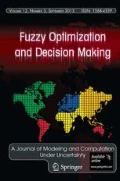Abstract
Data envelopment analysis (DEA) is a powerful analytical tool in operations research and management for measuring and estimating the efficiency of decision-making units. Both the inputs and the outputs are assumed to be known constants in the classical DEA models. However, in many cases, those data (e.g., carbon emissions and social benefit) cannot be measured in a precise way. Therefore, in this article, the inputs and outputs are considered as uncertain variables and a new uncertain DEA model is introduced. The sensitivity and stability of the new model are also analyzed. Finally, a numerical example of the new model is documented.
Similar content being viewed by others
References
Banker, R. D., Charnes, A., & Cooper, W. W. (1984). Some models for estimating technical and scale efficiencies in data envelopment analysis. Management Science, 30, 1078–1092.
Charnes, A., Cooper, W. W., & Rhodes, E. (1978). Measuring the efficiency of decision making units. European Journal of Operational Resarch, 2, 429–444.
Charnes, A., Cooper, W. W., Golany, B., Seiford, L., & Stutz, J. (1985). Foundations of data envelopment analysis for Pareto-Koopmans efficient empirical production functions. Journal of Econometrics, 30, 91–107.
Charnes, A., Haag, S., Jaska, P., & Semple, J. (1992). Sensitivity of efficiency calculations in the additive model of data envelopment analysis. Journal of Systems Science, 23, 789–798.
Cooper, W. W., Park, K. S., & Pastor, J. T. (1999). RAM: A range adjusted measure of inefficiency for use with additive models, and relations to other models and measures in DEA. Journal of Productivity Analysis, 11, 5–24.
Cooper, W. W., Seiford, L. M., & Tone, K. (2000). Data envelopment analysis: A comprehensive text with models, applications, references, and DEA-Solver software. Boston: Kluwer Academic.
Guo, P., Tanaka, H., & Inuiguchi, M. (2000). Self-organizing fuzzy aggregation models to rank the objects with multiple attributes. IEEE Transactions on Systems, Man, and Cybernetics-Part A: Systems and Humans, 30, 573–580.
Kahneman, D., & Tversky, A. (1979). Prospect theory: An analysis of decision under risk. Econometrica, 47, 263–292.
Lertworasirikul, S., Fang, S. C., Joines, J. A., & Nuttle, H. L. W. (2003a). Fuzzy data envelopment analysis (DEA): A possibility approach. Fuzzy Sets and Systems, 139, 379–394.
Lertworasirikul, S., Fang, S. C., Joines, J. A., & Nuttle, H. L. W. (2003b). Fuzzy data envelopment analysis: A credibility approach. In J. L. Verdegay (Ed.), Fuzzy sets based heuristics for optimization (pp. 141–158). Berlin: Springer.
Liu, B. (2007). Uncertainty theory (2nd ed.). Berlin: Springer.
Liu, B. (2009a). Theory and practice of uncertain programming (2nd ed.). Berlin: Springer.
Liu, B. (2009b). Some research problems in uncertain theory. Journal of Uncertain Systems, 3, 3–10.
Liu, B. (2010). Uncertainty theory: A branch of mathematics for modeling human uncertainty. Berlin: Springer.
Liu, B. (2012). Why is there a need for uncertainty theory. Journal of Uncertain Systems, 6, 3–10.
Liu, B., & Chen, X. W. (2015). Uncertain multiobjective programming and uncertain goal programming. Journal of Uncertainty Analysis and Applications, 3, 10.
Liu, B., & Yao, K. (2015). Uncertain multilevel programming: Algorithm and applications. Computers and Industrial Engineering, 89, 235–240.
Liu, Y. H., & Ha, M. H. (2009). Expected value of function of uncertain variables. Journal of Uncertain Systems, 4, 181–186.
Sengupta, J. K. (1992a). A fuzzy systems approach in data envelopment analysis. Computers and Industrial Engineering, 24, 259–266.
Sengupta, J. K. (1992b). Measuring efficiency by a fuzzy statistical approach. Fuzzy Sets and Systems, 46, 73–80.
Triantis, K. P., & Girod, O. (1998). A mathematical programming approach for measuring technical efficiency in a fuzzy environment. Journal of Productivity Analysis, 10, 85–102.
Wen, M. L. (2015). Uncertain data envelopment analysis. Berlin: Springer.
Wen, M. L., & Kang, R. (2014). Data envelopment analysis (DEA) with uncertain inputs and outputs. Journal of Applied Mathematics, 2, 1–7.
Acknowledgements
This work was supported by National Natural Science Foundation of China (Grant No. 61573210).
Author information
Authors and Affiliations
Corresponding author
Rights and permissions
About this article
Cite this article
Lio, W., Liu, B. Uncertain data envelopment analysis with imprecisely observed inputs and outputs. Fuzzy Optim Decis Making 17, 357–373 (2018). https://doi.org/10.1007/s10700-017-9276-x
Published:
Issue Date:
DOI: https://doi.org/10.1007/s10700-017-9276-x


